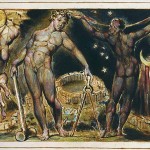“The witches have departed, leaving no addresses ; the last of them is now somewhere diminishing into distance, headed for the fields of amaranth and asphodel…” (Innes, 1984, p. 37).
As the Polytheist Leadership Conference drew nearer, I realized that the whole affair was an unknown quantity. I had no idea what to expect. I had spent the months prior preparing my presentation, itself a much more arduous process than I had anticipated, and so I had left myself with only the final week before the conference to actually consider just what I was doing. At this point in the game, it was far too late for me to be afraid, but I was certainly apprehensive. I had made a commitment, and had received so much support that I certainly could not back out. Anyway, I had done all of this work, and I would not allow myself to squander it.
Those who are familiar with my writing will know that community is my persistent refrain. It was exactly that which gave me pause. When we speak about community, the thing that we rarely speak about is love. When we do allude to love, it tends to be in a hidden or occluded way, as if this, too, we have surrendered. My fascination with community has been caught up for quite some time in the way that we tend to use the word to mean so many different things, and how we collapse all levels of community into one generic monolith, particularly when discussing religious experience. As recent debates surrounding the apparent unification of Polytheism have shown, Pagan community manifests its own hidden orthodoxies – community acts as normalizing force, a homogenization of spirituality. Is this a manifestation of love?
As the conference drew nearer, I could only return to my most disappointing experience with Pagan community – my trip to PantheaCon in 2013 with my husband and roommate. We found ourselves entirely adrift. It did not take long for us to realize that what we anticipated and hoped for was simply not to be found there. The few discussions that we did manage to strike up with other con-goers quickly guttered, and we were shocked to discover the hospitality suites to be quite astoundingly inhospitable. It seemed that this community was actually quite solidly gated, and that we had simply paid for the privilege of peeking through the fence into someone else’s party.
With all of this in mind, I sat in the terminal, listening to the Pines of Rome playing over the airport radio, waiting to board my flight. More than anything else, I simply felt vulnerable.
“And so much for the fantasy of the thing. What of its sober reason? One departs from one place because one designs – or because somebody else designs – that one should arrive in another” (Innes, 1984, p. 37).
When Sannion told me about the Polytheist Leadership Conference and invited me, back sometime in January or February, I felt as though I had only one option and must, of course, commit to going. My initial fit of vacillation was kept blessedly short by a strong sense of urgency: here was work that needed doing, how could I refuse? This was, for me, the call of community. Yet, community has always been something unsettlingly ambiguous.
Mallory and I spent the drive from the airport discussing politics, one of our favorite pastimes. For a while now, I have had a very hard time disentangling my spirituality from my politics, from my simple way of being in the world. When I express a political view, I am expressing a manifestation of my theology. Yet, this is really not the way that our nation is supposed to work. Politics and religion are inviolate, each in their own domain: we all know the rhetoric of separation, however ineffectual. Yet, how do we construct community outside of politics and religion?
The thrust of my presentation was that we, in America, despite our claims to the contrary, do essentially maintain a civic religion, and that religion is monotheistic. All we have accomplished in our pursuit of religious neutrality is the transfiguration of religion’s central term: no longer are we held in obeisance to God the Father, now we are bound by an image of Truth. My words seemed to be well received. Rhyd and I had been joking, leading up to the conference, that we would be very bad radicals indeed if, between the two of us, we were not responsible for causing at least one bloody nose. It was rather strange, then, to be met with so much agreement.
Religion and politics get so tangled up. Maybe it is time for us, then, to admit that our religious beliefs have profound ramifications. If I believe, deeply, then how can I keep that separate from everything else that I do? Religion, spirituality, are political. Yet, this produces a deep sense of anxiety.
Several times now, I have reflected on how egalitarian the Polytheist Leadership Conference was. There was manifested, in I what I can only describe as an intimate group, a broad range of backgrounds and experiences. While the demographics of the conference did most certainly reflect the demographics of Paganism in general, there was still a great deal of variation. There were people who had been practicing their traditions for decades, and others who were quite new. There were people with advanced degrees, and people with little formal education to speak of. None of that seemed to matter. We had come, and that was enough.
If this was a community, this cluster of less than a hundred people, it was an incredibly heterodox one. We had been gathered together by one single theological principle, the presence of many Gods. Yet, once we had arrived, it seemed to me that this single unifying factor quickly became the least interesting thing about us. Our differences ruled. I think, perhaps, that we began to see, there, a manifestation of love.
References:
Innes, M. (1984). The Daffodil Affair. Harmondsworth, England: Penguin Books, Ltd.
















